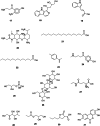Exploring the bioactive landscape: peptides and non-peptides from the human microbiota
- PMID: 40341751
- PMCID: PMC12062242
- DOI: 10.1038/s41522-025-00713-x
Exploring the bioactive landscape: peptides and non-peptides from the human microbiota
Abstract
The human microbiota, consisting of trillions of bacteria from six main phyla, produces peptide and non-peptide secondary metabolites which have antibacterial properties vital to medicine and biotechnology. These metabolites influence biological processes linked to diseases, yet much remains unknown. This review explores their structures and functions, aiming to spur novel metabolite discovery and advance drug development.
© 2025. The Author(s).
Conflict of interest statement
Competing interests: The authors declare no competing interests.
Figures


















Similar articles
-
Bioactive Specialized Metabolites from Staphylococcus: Diversity, Biosynthesis, and Biotechnological Potential.Chembiochem. 2025 Jun 3;26(11):e202500105. doi: 10.1002/cbic.202500105. Epub 2025 Apr 24. Chembiochem. 2025. PMID: 40139968 Review.
-
Antibacterial Potential of a Novel Peptide from the Consensus Sequence of Dermaseptin Related Peptides Secreted by Agalychnis annae.Curr Pharm Biotechnol. 2021;22(9):1216-1227. doi: 10.2174/1389201021666201020161428. Curr Pharm Biotechnol. 2021. PMID: 33081682
-
Bacterial Secondary Metabolite Biosynthetic Potential in Soil Varies with Phylum, Depth, and Vegetation Type.mBio. 2020 Jun 16;11(3):e00416-20. doi: 10.1128/mBio.00416-20. mBio. 2020. PMID: 32546614 Free PMC article.
-
Cell-selectivity of tryptophan and tyrosine in amphiphilic α-helical antimicrobial peptides against drug-resistant bacteria.Biochem Biophys Res Commun. 2018 Oct 28;505(2):478-484. doi: 10.1016/j.bbrc.2018.09.095. Epub 2018 Sep 27. Biochem Biophys Res Commun. 2018. PMID: 30268502
-
Recent progress of bacterial FtsZ inhibitors with a focus on peptides.FEBS J. 2021 Feb;288(4):1091-1106. doi: 10.1111/febs.15489. Epub 2020 Aug 2. FEBS J. 2021. PMID: 32681661 Review.
Cited by
-
The Interplay Between the Gut Microbiota and Colorectal Cancer: A Review of the Literature.Microorganisms. 2025 Jun 17;13(6):1410. doi: 10.3390/microorganisms13061410. Microorganisms. 2025. PMID: 40572299 Free PMC article. Review.
References
Publication types
MeSH terms
Substances
Grants and funding
LinkOut - more resources
Full Text Sources
Medical

